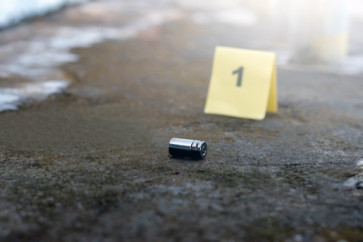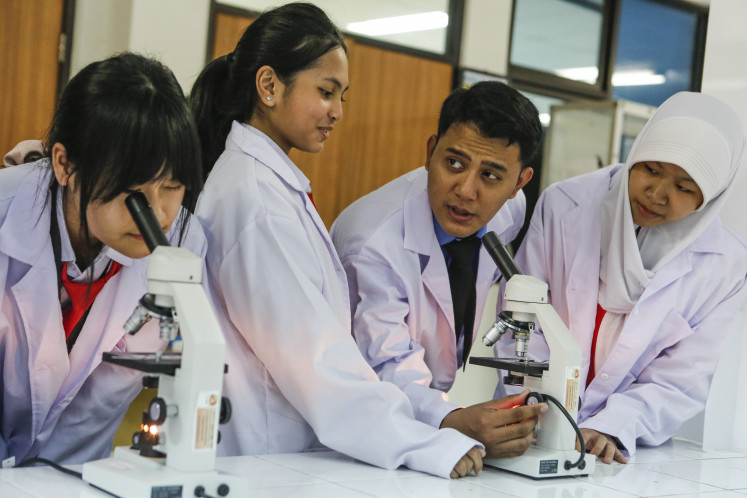Popular Reads
Top Results
Can't find what you're looking for?
View all search resultsPopular Reads
Top Results
Can't find what you're looking for?
View all search resultsShould a CT scan be the first step?
PREPARE TO SCAN: Prepare to scan: A cardiologist at Cinere Hospital, Dr
Change text size
Gift Premium Articles
to Anyone
PREPARE TO SCAN: Prepare to scan: A cardiologist at Cinere Hospital, Dr. Jeffrey Wirianto, prepares a patient for scanning using MSCT-64 Slices diagnostic tool, one of the equipments at the cardiovascular clinic at the hospital in Depok, West Java. (JP/R. Berto Wedhatama)
When my doctor fell silent as he stared at the screen of his ultrasound machine, I knew he was seeing something that he did not like.
I had told him that I had felt a slight discomfort just below my last right rib. On the screen he could see an irregular node on my liver just on the spot where I had pointed. He then suggested I get a CT scan performed on my entire abdomen.
I understood why he wanted this examination done on me, not least because there is some history of cancer in my family.
Although my own PSA (prostate-specific antigent), which is the test carried out to determine the occurrence of prostate cancer, is still very low, when it comes to physical health the last thing you want is a nasty surprise.
I have also had problems with my gallbladder and kidneys. My doctor often jokes that I am an avid producer of precious stones. A full abdomen CT scan would help check all these conditions in one sweep.
What is a CT – or computed tomography – scan?
Many people have the notion that a CT scan is a procedure that can be used to probe inside your brain to find out whether one of your blood vessels has burst and is flooding the inside of your head with blood.
The truth is that a CT – once known as CAT (computerized axial tomography) – scan can be performed to scan other parts of your body, including the heart, lungs and abdomen.
SEEING CLEARLY: Seeing clearly: An operator explains how the scanning process of the diagnostic tool works. (JP/R. Berto Wedhatama)
The CT scan captures cross-sectional images of our internal organs using X-rays.
Most hospitals now have 64-slice or 128-slice CT scan machines.
The state of the art equipment is capable to probe into our organs can produce around 500 slices, purportedly providing a more accurate picture of what is going on inside our body.
What is the main benefit of performing a CT scan?
It allows the physician to find any abnormality inside our body without having to cut us open. It is a painless way to examine what’s going on inside, and it can help determine the stage, spread or recurrence of tumors.
Something made me curious during my CT scan: Why, I wondered, did the operators leave the room when the procedure was being carried out? Once I was back home, I browsed the Internet to learn some more about CT scanning.
What I found most surprising of all is that the CT scan actually involves a high dose of radiation. There seems to be no consensus as to how much radiation is caused by a CT scan.
Some references on the Internet say that the level of radiation is equal to the radiation we would receive in 500 to 750 chest X-rays.
Other references go as far as saying that it is far less than what the people in Hiroshima and Nagasaki were exposed to in the years after the atomic bombs were dropped there.
Nonetheless, having a CT scan does carry some risks. Keep in mind that in many hospitals around the world, the physicians order a CT scan as the first measure in making their diagnosis.
There can be various reasons behind this quick decision.
First, modern hospitals invest a lot in modern medical equipment to build their reputation and to beat their competitors in attracting upscale patients. The investment has to be recouped somehow.
Second, although the cost of having a CT scan can be staggering for most people, more and more wealthy patients happily go into the scanning room to make sure quickly that there is nothing wrong with their health.
It takes only one to two hours, and it is a completely noninvasive procedure. Nevertheless, without prior consultation with the doctor, the CT scan – because of its high radiation – may in fact trigger a mutation inside our body and even wake up some malignant cells.
Some reports suggest that new generations of CT scan machines produce less radiation, though. The US Food and Drug Administration believes there is only a small chance that the radiation will be absorbed by the body and cause cancer.
But remember that there are other less risky and also painless investigative methods available, such as the ultrasound and Magnetic Resonance Imaging (MRI). They may be better suited for different goals, but they are the alternatives that can be considered.
A friend of mine, who is also a doctor, believes that ultrasounds, MRI, CT scans and other scanning tools can only provide supplementary information.
Several lab tests can be performed to provide a preliminary diagnosis.
The morning before I had my CT scan, I went to Prodia where I regularly take blood and urine tests. This time, I asked for the AFP and CEA tests, which my doctor had not ordered.
The AFP (alpha-fetoprotein) and CEA (carcinoembryonic antigen) are called “tumor markers”. They can indicate the presence or nonpresence of liver and colon cancers. My results were negative, which was quite reassuring.
So what does all this tell us?
First, it is important that you consult your physician before signing the statement of consent for the procedure. Your doctor should explain clearly to you the risks involved, and the two of you must weigh them against the benefits.
Second, whatever you feel, as you grow older and you notice some deterioration in your health, do visit your doctor and have tests performed more regularly. It is better to find out about a condition in its very early stages, so you will have the opportunity to manage it, through a change in your lifestyle, for example.
Third, if your doctor suggests a high-radiation test such as a CT scan, be sure to ask some tough questions. Most important, do not just go and have a CT scan performed on you because you can pay and because you want to have a look at the insides of your otherwise perfectly healthy body.











